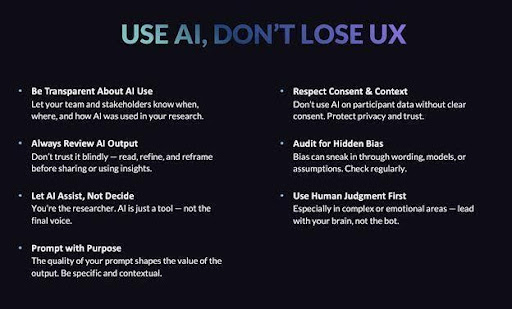AI is rapidly becoming embedded in nearly every part of game development and it’s only a matter of time before it becomes a standard part of game UX research workflows as well.
In this article, we explore with Maria Amirkhanyan, Head of Gaming Division at Duamentes, what responsible and effective use of AI in player research can look like from our perspective. We walk through best practices, ethical considerations, and practical examples across each stage of the research process.
In addition, Chunhui Zhu (Mixed Method UX researcher) shares some hands-on examples of using AI effectively in her everyday research work.
AI is transforming research in game development. It doesn’t just automate tasks, it shapes how we ask questions, read player behavior, and share findings. Done well, it speeds up discovery and helps manage complexity. Used carelessly, it flattens context and introduces bias.
Based on real-world use across UX, design, and product teams, we’ve identified five levels of AI adoption in player research – from basic prompting to fully integrated systems. Each level reflects a different mindset, skill set, and degree of responsibility. They range from hands-off prompting to context-aware collaboration.
Let’s walk through each one, starting with where most people begin.
Level 1: The Dump & Hope
This is the starting point for many teams. At this level, AI is treated like a magic button. Drop in a prompt (e.g. “summarize this interview”; “generate 10 survey questions”; “write a UX research plan”) and take the output at face value.
The biggest issue? AI is always confident, even when it’s wrong. Without human oversight, the output can be completely off-mark while still sounding polished. This creates a false sense of reliability and can lead teams to make decisions based on generic, misaligned, or outright misleading insights.
If your prompt says “give me the top three issues” and the transcript only includes two real concerns, AI will invent a third to match the request. It doesn’t push back or say “there aren’t three”. It simply fills the gap, even if that means making something up.
Level 2: Task Automation Without Oversight
At this stage, teams begin using AI for basic, repetitive tasks, e.g. transcribing interviews, generating first-draft survey questions, or tagging quotes from playtest sessions.
Instead of asking for vague summaries, the prompts are more specific: “Transcribe this 30-minute playtest”; “Generate 10 survey questions for this session”; “Tag key quotes from this feedback”.
These are time-consuming tasks, and AI can handle them quickly. Generic survey questions might miss the actual pain points. AI-generated tags can overlook context or emphasize the wrong signals entirely.
During playtests of an action shooter game, an AI-generated summary flagged a quote as confusion with game controls: “He didn’t throw the ball right, we’re going to lose because of this”. The moment was tagged as “confusing”. On review, we realized the participant had a basketball game playing on TV in the background. The comment was about a real-life match, not our game. AI had pulled the quote out of context and mislabeled it, leading to a completely inaccurate insight. At this stage, insight is shaped by AI, not researchers.
Level 3: Guided Assistance, Minimal Reflection
At level 3 teams begin to work with AI more deliberately. Instead of asking for full outputs, they give more precise instructions and steer the results: “Rewrite this question to avoid bias”; “Group these quotes by emotional tone”; “Summarize pain points, I’ll clean it up after”.
It’s a big improvement over Levels 1 and 2. More intention, more ownership, and often better results. The researcher is involved again, not just prompting, but refining.
Polished AI output can lead teams to overtrust it, making it easy to overlook hidden biases, missed nuance, or undocumented shifts in meaning that go unnoticed by stakeholders.
Level 3 feels efficient and thoughtful, but it can still drift from insight into automation if the researcher isn’t actively questioning the output. The collaboration is better, but the critical thinking still needs to catch up.
Level 4: Informed Collaboration
At this stage the relationship between AI and researcher starts to feel like a true partnership. Prompts are more detailed, grounded in game-specific context, and shaped by real goals.
You might ask: “Based on this mobile puzzle game and player type, generate five emotionally neutral survey questions”; “Highlight quotes that show frustration during onboarding”; “Compare usability pain points across sessions; ignore duplicates”.
This level offers real value. AI helps you explore patterns, highlight signals, and save time on structure, while you remain responsible for refining, reviewing, and presenting the final insight.
However, it’s easy to start over-trusting the AI’s ability to match context. You might think, “I gave it everything it needs, of course it should get it right!” but context in research isn’t just data. Tone, nuance, pacing, intent – these can still be misread or flattened.
We’ve also seen teams fail to document how AI was used in the process. That makes it hard to track what was AI-generated and what was researcher-driven, especially once insights are handed off to design or product teams.
This level requires transparency, clearly acknowledging AI’s role and correcting its oversimplifications before insights reach decision-makers.
Level 5: Integrated Systems, Invisible Decisions
At level 5 AI is no longer just a support tool, it becomes part of the research infrastructure. Teams use custom-tuned systems trained on their own data, tagging frameworks, and internal language. AI is embedded across workflows, from early analysis to reporting.
You might see prompts like: “Using our last 10 playtests, generate onboarding criteria for midcore strategy games”; “Apply our tagging model and flag emotional volatility for manual review”; “Create a dashboard summarizing friction points by player segment and intent.”
The advantage is clear: these systems can handle scale, reduce repetition, and make complex patterns easier to work with. They become powerful allies for research teams juggling multiple studies or live feedback cycles.
These setups tend to become black boxes. Few people fully understand how the system makes its decisions, especially if the prompts, training data, or assumptions aren’t documented clearly.
If AI helps interpret player data across tools, bias and consent risks grow harder to spot. At this level, real capability demands clear governance, ongoing review, and constant questioning to ensure insights remain ethical and human-centered.
AI Doesn’t Replace; It Challenges
AI is not here to replace researchers. It’s here to test our habits, raise the stakes, and force us to think more critically about how we work.
Used carelessly, AI can flatten player stories and quietly reshape how decisions get made. Used with intention, it can be a powerful partner which supports discovery, accelerates workflows, and helps us scale human-centered research without losing its core.
To wrap up, here’s an example of how the same research need (understanding onboarding pain points) might evolve across all five levels of AI use:
| Level | Example Prompt | What’s Happening |
| Level 1 | “Summarize this transcript.” | No context, no goals. AI fills in the blanks even if it means inventing insights. |
| Level 2 | “Tag the key pain points in this onboarding playtest” | Task delegation without review. Fast, but may miss nuance or misinterpret player emotion. |
| Level 3 | “Summarize onboarding friction in this playtest. I’ll edit for clarity” | More involvement but still leaning heavily on AI’s structure. Risk of subtle framing bias. |
| Level 4 | “Based on this game and audience, highlight quotes showing frustration during onboarding. Exclude duplicates and group by theme” | Context-aware and collaborative. The researcher shapes the direction and checks the results. |
| Level 5 | “Using our tagging model and recent onboarding studies, create a dashboard of friction points by player type and emotional intensity. Flag new patterns” | Fully integrated system. High efficiency but requires strong governance and transparency. |
Some Practical Examples of Using AI Effectively
AI can play a role throughout the research workflow. In the early stages, it helps generate ideas, draft surveys or interview guides, and organize planning materials. As the research progresses, it can support transcription, highlight patterns, or cluster similar insights, especially useful in qualitative work. Later, it can help synthesize findings, draft reports, or even design workshops. Whether you’re working with words or numbers, AI is most powerful when treated as a research assistant.
Prompting with Purpose: The IDEAS Framework
One of the best ways to get meaningful results from AI is to be thoughtful about how you prompt it. A simple structure can go a long way, such as the IDEAS framework:
- I – Identity: Define the AI’s role. (e.g., “You are a Game UX Researcher.”)
- D – Deliverables: Be clear about what you want it to produce.
- E – Examples: Share context or reference materials when possible.
- A – Ask: Spell out the task clearly.
- S – Specifications: Set expectations like tone, format, or word count.
This structure helps focus the AI and gives it just enough context to return relevant results.
Letting AI Guide You: Flipped Interaction
You don’t always need to know what to ask. Sometimes, it’s more effective to let the AI lead by asking you the right questions, step by step.
Say you’re planning a brainstorm session after research on inactive Apex Legends players. You could tell the AI: “I want to organize a brainstorming session after presenting research. Keep asking me one question at a time until you can propose a session plan.”
The AI might start with: “What’s the goal of the session?” Then move on to “How long should it be?” and “How many participants?”. It will build a custom plan collaboratively, rather than rely on a single big prompt.
This flipped interaction approach is especially useful when you’re still figuring things out or need structure for something complex, like a workshop or debrief.
Creating Prompts with AI’s Help
AI isn’t just good at answering prompts but it can also help you write them. When you’re not sure how to frame a request, just ask for help drafting the prompt itself.
For example: “Help me write a prompt to analyze survey data about player behavior.”
The AI might respond: “You are a data analyst. Review this survey data to identify key engagement trends and propose 2–3 areas to explore further. Summarize with visuals where possible.” This kind of prompt generation is great when you’re stuck or want to create more effective prompts.



































